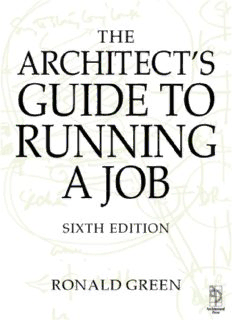
Architect's Guide to Running a Job PDF
Preview Architect's Guide to Running a Job
The Architect’s Guide to Running a Job for M & M The difficulty about a gentlemen’s agreement is that is depends on the continued existence of the gentlemen. The Architect’s Guide to Running a Job Sixthedition RONALDGREEN,RIBAAADipFCSD WithaforewordbySirHughCasson Architectural Press OXFORD AUCKLAND BOSTON JOHANNESBURG MELBOURNE NEW DELHI ArchitecturalPress AnimprintofButterworth-Heinemann LinacreHouse,JordanHill,OxfordOX28DP 225WildwoodAvenue,Woburn,MA01801-2041 AdivisionofReedEducationalandProfessionalPublishingLtd AmemberoftheReedElsevierplcgroup FirstpublishedbyTheArchitecturalPressLtd1962 Fourthedition1986 Fifthedition1995 Sixthedition2001 Reprinted1996,1997,1998,1999,2000 #RonaldGreen1986,1995,2001 Allrightsreserved.Nopartofthispublication maybereproducedinanymaterialform(including photocopyingorstoringinanymediumbyelectronic meansandwhetherornottransientlyorincidentally tosomeotheruseofthispublication)withoutthe writtenpermissionofthecopyrightholderexceptin accordancewiththeprovisionsoftheCopyright, DesignsandPatentsAct1988orunderthetermsofa licenceissuedbytheCopyrightLicensingAgencyLtd, 90TottenhamCourtRoad,London,EnglandW1P0LP. Applicationsforthecopyrightholder’swrittenpermission toreproduceanypartofthispublicationshouldbeaddressed tothepublishers BritishLibraryCataloguinginPublicationData Green,Ronald,1927June12- Thearchitect’sguidetorunningajob.–6thed. 1. Architecturalpractice–GreatBritain2. Architectural contracts–GreatBritain I. Title 692.800941 ISBN0750653434 PrintedandboundinGreatBritainbyMPGBooksLtd,Bodmin,Cornwall Contents in practice sequence Foreword vii 29 Materials 58 Noteto sixthedition viii 30 Schedules 60 Preface ix 31 Technical representatives 62 Introduction 1 32 Construction contract 64 1 Preliminary enquiries 2 33 Sub-trades 66 2 Officeprogramme 4 34 Practice 68 3 Conditions ofengagement 6 35 Sub-contract tenders 70 4 Architect’s apointment 8 36 Sub-contractor nomination 72 5 Client’s projectmanagement 10 37 Cost records 74 6 Siteinspection 12 38 Insurances 76 7 Survey 14 39 Liquidated and ascertained 8 Surveyguide 16 damages 78 9 Briefing process 18 40 Clerk ofworks’ appointment 80 10 Consultant recommendation 20 41 Clerk ofworks 82 11 Engineer appointment 22 42 Compiling tenderlist 84 12 Quantitysurveyor 43 Contract drawings 86 appointment 24 44 Quantity surveyor brief 88 13 Servicesconsultants 26 45 Completed quantities 90 14 Consultants’meetings 28 46 Contract stagefees 92 15 Muralsor sculpture 30 47 Tendering procedure 94 16 Statutoryrequirements 32 48 Pre-contract review 96 17 Statutoryrequirements: information guide 34 49 Recept oftenders 98 18 Designproposals 36 50 Preparation ofcontract documents 100 19 Presentingproposals 38 20 Interim fees 40 51 Placing the contract 102 21 Otherconsents 42 52 Contract interpretation 104 22 Adjoiningowners 44 53 Background toa building operation 106 23 Partystructure notices 46 54 The people involved 108 24 Partystructure settlement 48 55 Contractor’s programme 112 25 Drawingsprogramme 50 56 Adjoining properties 114 26 Construction/production drawings 52 57 Site reports 116 27 Public services 54 58 Site meetings 118 28 Environmental services 56 59 Architect’s instructions 120 vi Contents 60 Modifications 122 68 Maintenance information 142 61 Foundation stone 124 69 Practical completion 144 62 Siteprogress 70 Occupation andopening photographs 126 ceremony 146 63 Siteinspection 128 71 Defects liability 148 64 Siteinspection guide 130 72 Final certificate 150 73 Final fees 152 65 Certificate procedure 136 74 Records 154 66 Topping outceremony 138 75 Recommendations 156 67 Practical completion inspection 140 Bibliography 158 Foreword By Sir Hugh Casson First—infairnesstothereader—Imustdeclareaninterest.Theauthorofthisbook has been for many years a colleague and partner, and all of us with whom he has worked have personally learned much from his experience and skill in administra- tion,theprinciplesofwhichhehasnowbeenpersuadedtosetdowninprintforthe benefit of the profession in general. Much has been said and written in the past few years—and not before it was time—about the profession’s apparent reluctance or inability to face up to its administrative responsibilities. The belief has been allowed to grow up that good art and good administration are incompatible. A good designer to many people meansanarchitectwhocannotbetrustedtokeeptoabudgetoraprogramme.An able administrator implies ignorance of or indifference to visual matters. Neither charge is wholly untrue. Neither does the profession credit. Both undermine the architect’sclaimtobetheleaderofthebuildingteam.Thetruth—thetruismifyou like—is that (as the author remarks) designingand administrationare integralparts of a job—each of which demand, and must receive, a proportion of everybody’s timeintheoffice,whetherhebetheseniorpartnerorthemostjuniordraughtsman. Thearchitecthasadutytotheclienttorunajobefficiently.Equallyimportantishis dutytohimselftospendnomoretimeuponitthanisneededtoensurethatitisdone properlyandwell.Thisisexactlywhatthisbookisdesignedtohelpusachieve.Here you will find, set out in correct sequence—from the brisk ice-cold commonsense of its opening paragraph to the final warm-hearted words of parting advice—and without recourse to management jargon, all the many operations from site inspec- tion to briefing a mural painter, from party-wall procedure to the nomination of sub-contractors, that may be met with in running a job of any size from any office, large or small. As areference book, information chart or check-list, it will be found invaluable. This Page Intentionally Left Blank Note to sixth edition The objectives of this book are clear from the introduction though since its first publication alternative ways of commissioning buildings have been adopted which make the identification of the historically conventional route from design to com- pletion,underthedirectionofthearchitect,onlyoneofmanybeingpractisedtoday. As in earlier revisions of this book this has led to a reduction in reference to specific documentation. It is assumed that the reader will look to other books or publications for detailed information related to alternative routes or procedures. With this route, however, the underlying pattern remains the same for commis- sionswhichrequirethearchitecttosteertheworkthroughfromenquirytooccupa- tion. The present training of an architect and the required level of qualification to permit the use of the title assumes this to be the case. This edition therefore has aimed to update the contents in line with present-day practice bearing in mind changing terminology, technology, legislative background and environmental demands. Ways and means will continue to change but the constants will all require attention if the translation of the design from two into three dimensions is to provide a building which both satisfies the client’s needs and produces a piece of architecture.
Description: